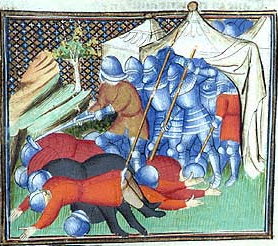Siege of Meaux
| date | October 1421 to May 10, 1422 |
|---|---|
| place | Near Meaux |
| output | English victory |
| Parties to the conflict | |
|---|---|
| Commander | |
|
Governor (?) Varaus |
|
| Troop strength | |
| less than 4,000 | unknown |
| losses | |
|
unknown |
unknown |
Chevauchées of the 1340s: Saint-Omer - Auberoche
Edward III. Campaign (1346/47): Caen - Blanchetaque - Crécy - Calais
War of the Breton Succession (1341–1364) : Champtoceaux - Brest - Morlaix - Saint-Pol-de-Léon - La Roche-Derrien - Tournament of Thirty - Mauron - Auray
France's allies : Neville's Cross - Les Espagnols sur Mer - Brignais
Chevauchées of the 1350s: Poitiers
Castilian Civil War & War of the Two Peter (1351–1375): Barcelona - Araviana - Nájera - Montiel
French counter-offensive: La Rochelle - Gravesend
Wars between Portugal and Castile (1369– 1385): Lisbon - Saltés - Lisbon - Aljubarrota
Battle of Northern France: Rouen - Baugé - Meaux - Cravant - La Brossinière - Verneuil
Jeanne d'Arc and the turn of the war: Orléans - Battle of the herring - Jargeau - Meung-sur-Loire - Beaugency - Patay - Compiegne - Gerberoy
The siege of Meaux lasted from October 1421 to May 1422 and was part of the Hundred Years War between England and France . The besieging English troops were led by Henry V who fell seriously ill during the siege and died as a result on August 31, 1422.
prehistory
Henry was crossed from England to France with 4,000 men in June 1421 and immediately after landing set out to relieve Thomas Beaufort, 1st Duke of Exeter , in Paris . This was threatened by several French armed forces stationed in Dreux , Meaux and Joigny . The king captured Dreux after only a short siege and then turned south. He conquered Vendôme and Beaugency before marching on Orléans . But since he did not have enough supplies to besiege such a large and well-fortified city, he turned north after only three days and first conquered Villeneuve-le-Roi , and then marched on Meaux.
Course of the siege
The city's defenses were led by a man named Vaurus - presumably the city's governor - who had a reputation for being a cruel and vicious person, but was considered a brave commander nonetheless. The siege by the English began in October 1421. The walls were soon torn down through tunneling and bombardment with siege weapons. Nevertheless, the city was not taken immediately. Due to serious illnesses that spread in the English camp, they suffered heavy losses. Among the epidemic deaths was John Clifford, 7th Baron de Clifford , who had already fought in the siege of Harfleur and the battle of Agincourt and who had later accepted the surrender of Cherbourg . Modern historians estimate that around a sixteenth of the besiegers died of dysentery and smallpox . Later in the siege, King Henry also fell ill. But he refused to leave the camp before Meaux was captured.
On May 9, 1422, the city finally surrendered to the English, whereby the garrison initially refused to surrender. After persistent bombardment, this also surrendered the following day. Vaurus was hung from a tree that has been called the Tree of Vaurus ever since. By the time Meaux surrendered, Henry was already seriously ill.
consequences
The city of Meaux remained under English rule until 1436 when it finally fell under the control of the French crown. After the siege was over, Henry made his way back to England. On the way to Bois de Vincennes , where he arrived on August 10th, he was no longer able to ride and had to be carried the rest of the way. There he died on August 31, 1422 at the age of 35.
literature
- Desmond Seward: The Hundred Years War. The English in France. 1337-1453. Atheneum, New York NY 1978, ISBN 0-689-10919-9 .
Individual evidence
- ^ Biographical data of John Clifford at Tudorplace.com
- ↑ cf. Seward: The Hundred Years War. 1978, pp. 186-187
